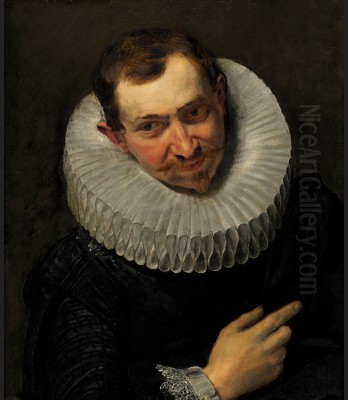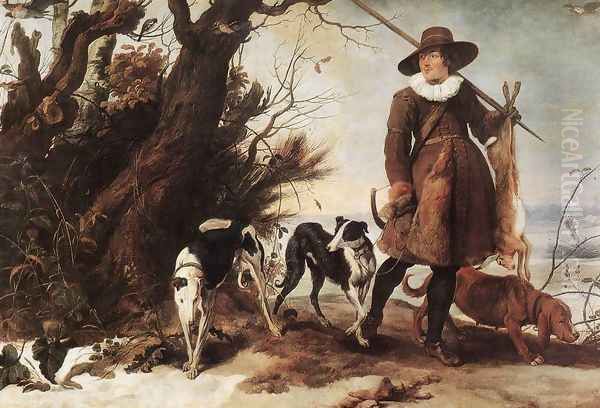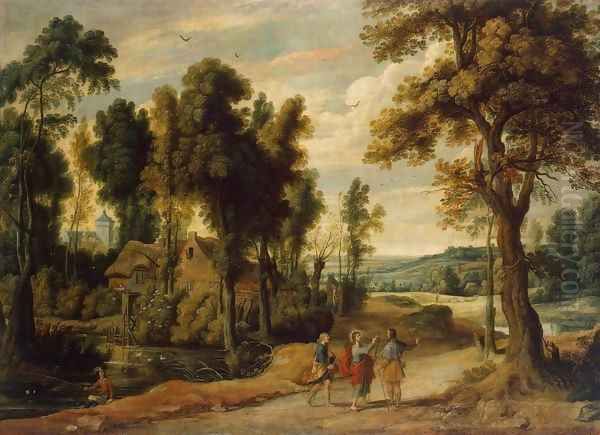
Jan Wildens (1586–1653) stands as a significant, if sometimes overshadowed, figure in the vibrant tapestry of Flemish Baroque art. Born in Antwerp, the bustling artistic and commercial heart of the Spanish Netherlands, Wildens carved a distinguished career as a painter and etcher, specializing primarily in landscapes. His meticulous attention to detail, his ability to capture the serene beauty of nature, and his frequent collaborations with the titans of his era, most notably Peter Paul Rubens, cemented his place in art history. Wildens was not merely a painter of backgrounds; he was an artist who understood the profound interplay between human drama and the natural world, contributing significantly to the development and popularization of landscape painting as a respected genre.
Early Life and Artistic Formation in Antwerp
Jan Wildens was born in Antwerp in 1586. The city at this time was a crucible of artistic innovation, still basking in the legacy of earlier Netherlandish masters like Pieter Bruegel the Elder, whose panoramic landscapes and genre scenes had a lasting impact. Wildens's early artistic training was under Pieter van der Hulst I (also known as Peter Verhulst), a lesser-known painter, but one who evidently provided him with a solid foundation in the craft.
By 1604, at the young age of approximately 18, Wildens was enrolled as a master in the prestigious Antwerp Guild of St. Luke. This was a crucial step for any aspiring artist, as guild membership granted the right to take on pupils and sell works independently. His early acceptance into the guild speaks to his precocious talent and the quality of his training. In these formative years, he would have been exposed to the works of contemporary Antwerp landscape specialists such as Joos de Momper and Gillis van Coninxloo, whose styles were transitioning from the more fantastical, Mannerist "world landscapes" to a more naturalistic approach.

Around 1610, Wildens established his own workshop, a testament to his growing reputation. It was during this early period that he embarked on an ambitious project: a series of twelve paintings depicting the months of the year. These works, including titles like "January, Skating on the Frozen River" and "April, Works in a Garden" (both circa 1614), demonstrated his burgeoning interest in realism and his acute observation of the changing seasons and rural life. These paintings were not just allegorical representations but also detailed depictions of the Flemish countryside, filled with anecdotal details of peasant activities, reflecting an engagement with the tradition of Bruegel the Elder but with a distinctly 17th-century sensibility.
The Italian Sojourn and Its Influence
Like many ambitious Northern European artists of his time, Jan Wildens recognized the importance of an Italian sojourn. Italy, particularly Rome, was considered the ultimate finishing school, a place to study classical antiquity and the masterpieces of the Italian Renaissance and contemporary Baroque. Wildens traveled to Italy around 1613-1614 and remained there until approximately 1616.
During his time in Italy, he would have encountered the works of Italian landscape painters such as Annibale Carracci, whose idealized classical landscapes were highly influential, and Adam Elsheimer, a German painter active in Rome whose small, poetic landscapes on copper had a profound impact on many artists. He also likely saw the developing work of Claude Lorrain and Nicolas Poussin, who were forging new paths in classical and ideal landscape.
Crucially, it is believed that Peter Paul Rubens was also in Italy during part of this period, or at least their paths and influences crossed. The experience of Italy, with its different light, vegetation, and artistic traditions, undoubtedly broadened Wildens's artistic horizons. While his style remained rooted in Flemish naturalism, his compositions may have gained a greater sense of order and monumentality, and his palette potentially enriched by the warmer tones of the Italian landscape. Upon his return to Antwerp, he was well-equipped to take his place among the leading artists of the city.
A Pivotal Collaboration: Peter Paul Rubens
The most defining aspect of Jan Wildens's career was his close and enduring professional relationship with Peter Paul Rubens, the undisputed giant of Flemish Baroque painting. After Wildens returned from Italy around 1616, he became a regular and trusted collaborator in Rubens's highly productive workshop. Rubens, known for his dynamic figure compositions, often delegated the landscape portions of his large-scale commissions to specialists, and Wildens quickly became one of his preferred choices.
This collaboration was mutually beneficial. Wildens brought his specialized skill in rendering detailed and atmospheric landscapes, which provided convincing and often emotionally resonant settings for Rubens's figures. In return, working with Rubens offered Wildens unparalleled exposure, prestigious commissions, and the opportunity to contribute to some of the most important artistic projects of the era.

One of the earliest and most significant collaborations was on the tapestry series depicting the History of Decius Mus (circa 1616-1618), designed by Rubens. Wildens was responsible for the extensive landscape backgrounds in the cartoons for these tapestries. His ability to create expansive, believable natural settings was crucial to the overall impact of these grand designs.
Wildens also contributed landscapes to many of Rubens's easel paintings. For instance, in Rubens's dramatic mythological painting, "The Rape of the Daughters of Leucippus" (circa 1618, Alte Pinakothek, Munich), the lush, vibrant landscape that forms the backdrop to the tumultuous scene is attributed to Wildens. His landscape work here is not merely decorative but enhances the energy and drama of the figures. Similarly, he provided the landscape for Rubens's "Cimon and Efigenia" (Kunsthistorisches Museum, Vienna) and "Jason and the Golden Fleece."
The collaboration extended to hunting scenes, a popular genre. Rubens, often in partnership with the animal specialist Frans Snyders, would paint the figures and primary animals, while Wildens would create the dynamic forest or open-country settings. This division of labor, common in Antwerp workshops, allowed for efficient production of high-quality, complex paintings. The styles of the artists blended seamlessly, a testament to their shared artistic vision and mutual respect. Wildens's landscapes in these works are characterized by their energetic rendering of foliage, dramatic skies, and a sense of deep space, perfectly complementing the vigor of Rubens's figures and Snyders's animals.
Other Collaborations and Artistic Connections
While his association with Rubens was paramount, Jan Wildens also collaborated with other prominent Antwerp painters. His specialization in landscape made him a valuable partner for artists who focused on figures, animals, or still lifes.
He had a close familial and professional connection with Cornelis de Vos, a leading portrait and history painter. Wildens married Maria Stappaert in 1619, and Maria's sister, Susanna Cock, was married to Cornelis de Vos, making them brothers-in-law. This family tie likely fostered artistic collaboration. For instance, in works where de Vos painted figures, Wildens might have provided the landscape elements.
Wildens also worked with Paul de Vos, Cornelis's brother and a renowned animal painter, particularly of hunting scenes and stable interiors. Their joint work, such as "Diana and Nymphs and Diana and Actaeon" (circa 1635-1640), showcases Paul de Vos's skill in depicting animals within landscapes crafted by Wildens. These collaborations highlight the interconnectedness of the Antwerp artistic community.
Frans Snyders, another leading animal and still-life painter, frequently collaborated with Rubens, and by extension, his circle would have included Wildens. While direct collaborations between Snyders and Wildens on independent pieces (without Rubens as the primary designer) are less documented, their work often appeared side-by-side in larger projects orchestrated by Rubens.
Jacob Jordaens, another major figure of the Antwerp school, often painted large-scale genre scenes and mythological subjects. While Jordaens was capable of painting his own backgrounds, the collaborative nature of Antwerp's art scene means interactions or shared influences with landscape specialists like Wildens were probable.
The artistic environment of Antwerp was rich with talent. Figure painters like Abraham Janssens, Gaspar de Crayer (though more active in Brussels), and the younger generation including Anthony van Dyck (before he left Antwerp) all contributed to the city's artistic ferment. Landscape painting itself was a thriving genre, with contemporaries like Jan Brueghel the Elder and his son Jan Brueghel the Younger, Lucas van Uden (another Rubens collaborator), and Adriaen Brouwer (known more for peasant scenes but also adept at landscapes) all active. Wildens operated within this dynamic milieu, both contributing to and drawing from its creative energy.
Wildens's Independent Landscapes and Style
Beyond his collaborations, Jan Wildens produced a significant body of independent landscape paintings. These works allow for a clearer appreciation of his personal style and artistic concerns. His landscapes are characterized by a move towards greater naturalism compared to earlier Flemish traditions. While often idealized to some extent, they are rooted in careful observation of the Flemish countryside.
His "Winter Landscape with a Hunter" (1624, Gemäldegalerie Alte Meister, Dresden) is a prime example of his mature style. The painting captures the stark beauty of a snow-covered landscape, with finely rendered trees, a frozen river, and a sense of deep, atmospheric perspective. The inclusion of the hunter and his dogs adds a narrative element, but the landscape itself is the primary subject, evoking a specific mood and season. This work, and others like it, show an affinity with the winter scenes popularized by Pieter Bruegel the Elder, yet with a softer, more atmospheric quality typical of the Baroque.
Another notable work is his "Panoramic view of the city of Antwerp across the River Scheldt" (17th century, Rijksmuseum, Amsterdam). This expansive vista demonstrates his skill in handling large-scale compositions and capturing the specific topography and atmosphere of a recognizable location. Such cityscapes combined with extensive foreground landscapes were popular, celebrating civic pride and the beauty of the surrounding region.
Wildens also painted landscapes with biblical or mythological themes, where the figures, though present, are often subordinate to the grandeur of the natural setting. "The Landscape with Christ and His Disciples on the Road to Emmaus" (1640) is an example. Here, the religious narrative unfolds within a serene and meticulously detailed landscape, emphasizing the divine presence within the natural world. The tranquility and careful rendering of light and foliage are characteristic of Wildens's approach.
His landscapes often feature a balanced composition, with a clear foreground, middle ground, and background leading the eye into the distance. He was adept at depicting varied textures of foliage, the play of light through trees, and the subtle gradations of color in the sky. While his palette could be rich, particularly in autumnal scenes, there is often a prevailing sense of calm and order in his independent works, contrasting with the more dynamic and dramatic landscapes he sometimes created for Rubens's more tumultuous scenes.
The Wildens Gallery and Business Acumen
Jan Wildens was not only a talented artist but also a savvy businessman. After his mother's death, he inherited her house, the "Gulden Rinck," on Lange Nieuwstraat in Antwerp. He transformed part of this property into a picture gallery, which became a significant venue for the display and sale of art.
His gallery reportedly housed an impressive collection of over 700 paintings, including works by contemporary artists and Old Masters. This venture indicates Wildens's deep engagement with the art market and his role as a connoisseur and dealer, in addition to being a creator. The gallery would have served as a hub for artists, collectors, and patrons, further solidifying Wildens's position within the Antwerp art world.
A poignant testament to his close relationship with Rubens is that after Rubens's death in 1640, a significant portion of the contents of Rubens's renowned studio and collection was moved to Wildens's gallery for inventory and sale. This task would only have been entrusted to someone of high standing and trustworthiness within Rubens's inner circle. It underscores the deep personal and professional bond between the two artists. Wildens's gallery thus played a crucial role in the dispersal of Rubens's artistic legacy.
Printmaking and Other Artistic Ventures
In addition to his prolific output as a painter, Jan Wildens was also active as an etcher. He produced a number of landscape prints, which helped to disseminate his compositions to a wider audience. His etchings, like his paintings, are characterized by their fine detail and atmospheric quality. Printmaking was an important aspect of the art market in the 17th century, allowing artists to reach collectors who might not be able to afford original paintings.
There is also mention of Wildens being involved in the decoration of keyboard instruments, such as harpsichords. The lids and cases of these instruments were often elaborately painted, frequently with landscape or mythological scenes. This type of decorative work was common for versatile artists of the period and demonstrates another facet of Wildens's artistic practice.
Family, Pupils, and Lasting Legacy
Jan Wildens's marriage to Maria Stappaert in 1619 not only connected him to the de Vos family but also, through Maria's relation to Helena Fourment (Rubens's second wife), further integrated him into Rubens's extended family circle. This network of familial and professional relationships was characteristic of the close-knit Antwerp art community.
Wildens had several pupils, ensuring the continuation of his artistic approach. Most notably, his own sons, Jan Baptist Wildens (born 1620) and Jeremias Wildens (born 1621), trained under him and became painters themselves, specializing, like their father, in landscapes. While neither achieved the same level of fame as Jan Wildens Sr., they carried on his tradition.
Jan Wildens died in Antwerp on October 16, 1653, leaving behind a substantial body of work and a significant reputation. His influence on the development of Flemish landscape painting was considerable. Through his independent works, he contributed to the growing naturalism and refinement of the genre. Through his collaborations, particularly with Rubens, he helped to elevate the status of landscape painting, demonstrating its crucial role in enhancing narrative and emotional impact in large-scale history paintings.
His ability to create varied and atmospheric settings – from tranquil pastoral scenes to dramatic, stormy forests – made him an invaluable asset to his collaborators. Artists like Lucas van Uden, who also worked with Rubens, and later landscape painters in the Southern Netherlands, would have looked to Wildens's achievements. His detailed yet harmonious style provided a bridge between the earlier, more stylized landscapes and the increasingly naturalistic approaches of the later 17th century.
Conclusion: An Enduring Contribution to Flemish Art
Jan Wildens was a master of the Flemish Baroque landscape, an artist whose skill and vision significantly enriched the art of his time. While often discussed in the context of his collaboration with Peter Paul Rubens, his independent works reveal a distinct artistic personality, characterized by a deep appreciation for the natural world and a remarkable ability to translate its beauty and diversity onto canvas and copper.
His prolific output, his successful gallery, and his role in training the next generation of painters underscore his importance in the Antwerp art scene. From the detailed charm of his "Months" series to the grand vistas created for Rubens's epics, and the serene beauty of his independent winter scenes or panoramic views, Wildens demonstrated a consistent mastery of his craft. He remains a key figure for understanding the evolution of landscape painting in the 17th century, a specialist who elevated his chosen genre and left an indelible mark on the rich legacy of Flemish art. His works continue to be admired in museums worldwide, offering a window into the lush, atmospheric world of the Flemish Baroque.